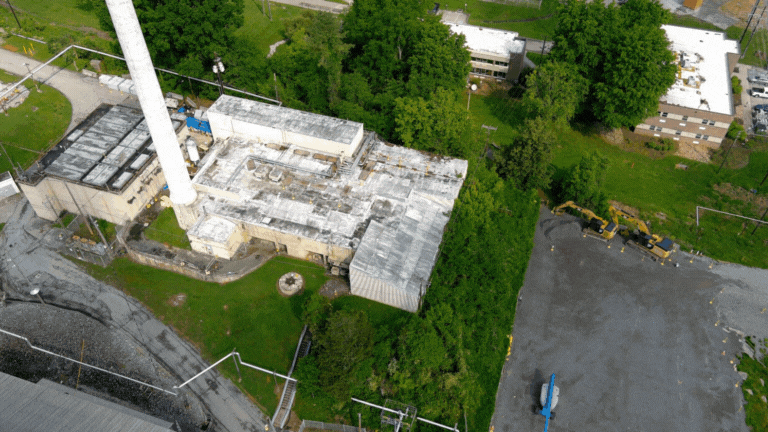The Oak Ridge Office of Environmental Management and contractor UCOR have completed demolition of another aging, contaminated structure at Oak Ridge National Laboratory, the latest in a line of projects steadily removing risks and transforming the heart of the site to enable future modernization. September 9, 2025
Office of Environmental Management
September 9, 2025Aerial views show the Graphite Reactor support facilities prior to demolition and with demolition underway. They include Building 3003, right, Building 3002, left, and the Building 3018 stack, center. These structures are located on a small footprint in a heavily congested area atop of a hill at Oak Ridge National Laboratory.
OAK RIDGE, Tenn. — The Oak Ridge Office of Environmental Management (OREM) and contractor UCOR have completed demolition of another aging, contaminated structure at Oak Ridge National Laboratory (ORNL), the latest in a line of projects steadily removing risks and transforming the heart of the site to enable future modernization.
Demolition of Building 3003 began in June and workers finished removing debris from the project in recent weeks.
Removal of the facility cleared 10,000 square feet of space essential to support future teardowns of neighboring facilities. Heavy equipment operators now have room necessary to demolish the adjacent Building 3002 and Building 3018, a 200-foot-tall stack.
“While finishing up deactivation and making our way to demolition start, challenges would arise, but all were faced with teamwork and problem-solving mindsets,” said UCOR ORNL Area Cleanup Project Manager Zachary Dew. “The skill of our craft and strength of our partnerships provided us with a clear path to success. I’m thankful to all involved for their part in making this project a success.”
Crews completed final debris removal from the Building 3003 footprint in August. This project cleared 10,000 square feet of space essential to support demolition of two remaining Graphite Reactor support facilities.
Located on a small footprint in a heavily congested area on a hilltop, Building 3003 presented many challenges during demolition.
To overcome spatial constraints, OREM and UCOR developed a plan to use the nearby footprint of the former Low Intensity Test Reactor. Workers built a ramp connecting the two areas and used the footprint to reduce the size of debris and load 80 shipments of that waste for disposal without further congesting the active demolition site.
Built in 1943, Building 3003 contained a fan house and provided ventilation for the Graphite Reactor. The fan house drew air from the reactor through underground ducts and released it through the stack.
Workers built a ramp connecting the Building 3003 demolition site to the nearby footprint of the former Low Intensity Test Reactor. Linking the two sites helped overcome spatial constraints so crews could reduce the size of debris and load shipments of that waste for disposal without further congesting the active demolition site.
Constructed in only nine months, the Graphite Reactor achieved criticality in 1943, and it was the world’s first continuously operating nuclear reactor. Its initial mission involved showing plutonium could be extracted from irradiated uranium. After the Manhattan Project, it supported nuclear energy and medical research missions.
The Graphite Reactor was shut down in 1963, and it was designated a national historic landmark in 1965. Today, the facility is part of the Manhattan Project National Historical Park. Taking down Building 3003 has removed risks near the historic facility, opened land for reuse and enhanced access for park visitors.
Planning and preparation are ongoing for the demolition of the two remaining Graphite Reactor support facilities. Teardown of Building 3002 and Building 3018 will occur in coming years.
-Contributor: Carol Hendrycks
To receive the latest news and updates about the Office of Environmental Management, submit your e-mail address.





